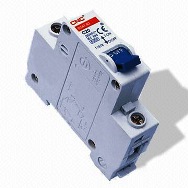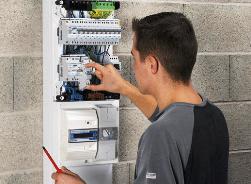Categories: Electrician at home, Electrical Reviews, Automata and RCD
Number of views: 124846
Comments on the article: 12
Overview of circuit breakers
Overview of different types of circuit breakers with prices and features
 Circuit breakers present in any modern building, they are usually mounted on a 35mm DIN rail. The exception is the previously widely used black “automatic machines” of the AE series, which are now better not to use, because they are inferior to modern in all respects except the price.
Circuit breakers present in any modern building, they are usually mounted on a 35mm DIN rail. The exception is the previously widely used black “automatic machines” of the AE series, which are now better not to use, because they are inferior to modern in all respects except the price.
Circuit Breakers are devices for protecting electrical circuits from overloads and short circuit currents.
A critical situation in the electrical circuit occurs when the load is too powerful, or during a short circuit. To understand how the circuit breaker saves in these situations, you need to understand its principle of operation.
Design and description of circuit breakers
Let's start with the design.
Main components of circuit breakers this is:
1. Arcing chamber;
2. Thermal release;
3. Electromagnetic release;
4. Release mechanism;
5. The control lever;
6. Connecting devices;
7. Connection terminals, i.e. screws for clamping wires, contact system.
It would seem that there are so many little things, but it is the little things that determine quality. For example, an insufficient number of rivets for connecting the case leads to a skew and jamming of the mechanism when tightening the connecting wires in the terminals of the circuit breaker.
Now briefly the principle of operation of the machine. When the current in the circuit of the machine exceeds the working one by a factor of several, the thermal release is activated. With a short circuit, the current increases by tens or even hundreds of times and the electromagnetic release is activated, and the arcing chamber does not allow a fire to develop.
How to choose a circuit breaker?
 It is necessary to choose the correct circuit breaker. The selection sequence is as follows: load wiring, automatic wiring. The current of the machine must be less than the maximum wiring current.
It is necessary to choose the correct circuit breaker. The selection sequence is as follows: load wiring, automatic wiring. The current of the machine must be less than the maximum wiring current.
For example, if we talk about apartment wiring, then for lighting, copper wires with a cross section of 1.5 square and an automatic machine at 16 A are used, for sockets 2.5 square and an automatic machine at 25 A. For reference, the maximum currents for two-wire wires of the specified section laid in air, 19 A and 27 A, respectively.
If you come to the store, you will see that in addition to current, circuit breakers also differ in letter code or type of time - current characteristics.
A - for protection of greater value over long distances and electronic devices.
B - for symmetrical general purpose circuits.
C - for lighting networks of motors and transformers.
D - for circuits with inductive load and electric motors with high inrush currents.
K - for circuits with inductive load.
Z - for electronic devices.
From experience, the most common type C machines are. Remember that such a gradation is very arbitrary, rather it is an integral characteristic of its behavior in the event of a short circuit. For example, a type C circuit breaker has a greater overload capacity than type B.
Now, it is possible and necessary to talk about which vending machines and which types are better to buy. It is not strange, but still the appearance can say a lot about the quality of the product. If you see dents and chips on the circuit breaker case, rusty screws, fuzzy labels, then it is better to refuse such a product, despite the price.
Automatic machines of the AE series
These circuit breakers are best avoided, as This is an obsolete type of circuit breaker. Disadvantages: fragile housing, the impossibility of mounting on a DIN rail and the difficulty of replacement, the absence of an electromagnetic circuit breaker in some types (type 2). Maximum currents 10 A, 16 A, 25 A, etc. up to 250 A. Outdated design.
Automatic machines of the VA series
 These circuit breakers are quite modern and can be recommended as a replacement for automatic machines of the AE series. Such circuit breakers can be installed on a DIN rail; some manufacturers make special adapter strips for installing circuit breakers of the BA series instead of automatic machines of the AE series.
These circuit breakers are quite modern and can be recommended as a replacement for automatic machines of the AE series. Such circuit breakers can be installed on a DIN rail; some manufacturers make special adapter strips for installing circuit breakers of the BA series instead of automatic machines of the AE series.
If we talk about domestic use, then the VA series includes products for currents of 0.5 - 63A, with a characteristic of B, C, D, breaking capacity of 4.5 kA, the number of poles 1-4, wear resistance of 20,000 operations, the operating time of 6000-10000 hours.
The most widespread cheap automatic machines of IEK, DEK, INTES, EKF, Kontaktor and other domestic firms. An acceptable price / quality ratio of domestic products can be noted. For example, common automatic machines for 16 and 25 A cost about 40 rubles. For comparison, a similar Siemens will cost about 256 rubles. In the author’s opinion, tested by application experience, Siemens should be taken at a price of 80-100 rubles.
Schneider Electric Assault Rifles
It is easy to find products for currents 6-63A, with characteristic C, D, breaking capacity 4.5 kA, number of poles 1-3, wear resistance 20,000 operations, operating hours 10,000 hours.
By all characteristics, it is no better than good domestic ones. They differ in a pleasant appearance and at a price of 130 rubles. It is already quite possible to take them instead of Siemens circuit breakers.
Automatic machines ABB, Legrand, Siemens
You can call these machines premium products. Unless of course you bought a fake, which are many on the market. Original products can be distinguished by high-quality plastic housing, a larger number of fastening rivets (5 vs. 4 for conventional machines).
These machines have approximately twice as much overload current capacity of 6-8 kA, mechanical wear resistance and MTBF. There is also an additional service (covers, indicators, etc.). If you are willing to pay 5-6 times the price for the machine, then this is your choice.
conclusions
I would like to note that the machines are of course an important, but far from the only part of the wiring. If you choose expensive machines, then everything else (wires, sockets, boxes, panels, electrics) should be approximately the same price category. Remember that "where it is thin, there it breaks." If you do not save on materials, then do not save on specialists. The quality of the wiring very much depends on compliance with the installation technology.
See this topic:Comparison of circuit breaker designs
See also at bgv.electricianexp.com
:
